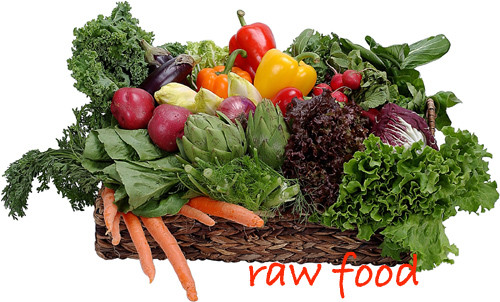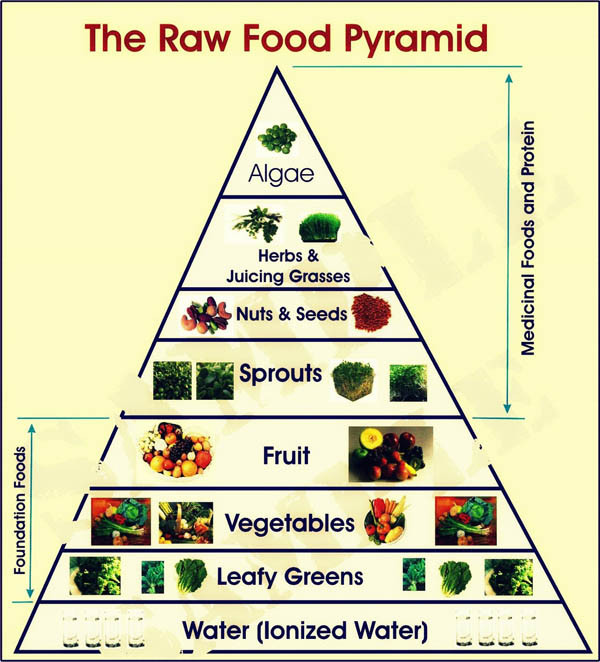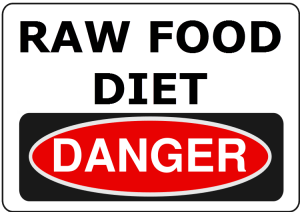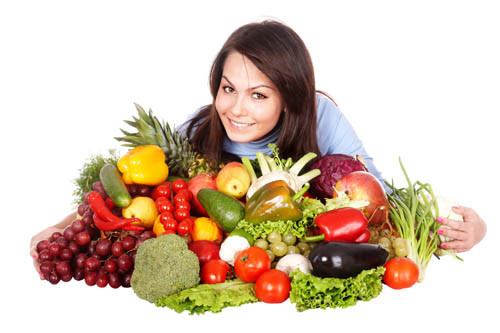
As we become more health conscious, there are a variety of diets people follow, believing them to have relevant health giving properties. Increasingly, people believe that cooking, or indeed processing food in any way reduces its nutritional benefits, and therefore the raw food diet has been born. To constitute a raw food diet, a minimum of three-quarters of the diet should consist of uncooked food. Raw foodists believe that the higher this proportion is, the healthier you will be.
Many raw foodists are also vegans, not consuming any animal products, but others do eat raw meat and fish, and even eggs as part of their diet.
Contents
Different paths
There are four different ways people can choose to follow a raw food diet, which are laid out below.
Raw vegetarians
The only animal products consumed are raw eggs and fresh dairy
Raw vegans
No animal products consumed at all. Often these people eat a higher proportion of raw food, and consider their diet to be purer.
Raw omnivores
Both plant and animal based foods are mainly consumed raw
Raw carnivores
Meat and fish products are eaten only raw
What foods are permitted on the diet?
Since the raw food movement is not intended to be anything more than a healthy way to eat, nothing is banned or permitted, as such. People make their own decisions. However, the diet usually consists of:
- Fresh fruits and vegetables
- Juiced fruit and vegetable
- Grains
- Legumes
- Coconut water
- Nuts
- Beans
- Dried fruits
- Purified water
- Seaweeds
- Seeds
- Sun-dried fruits
Depending on which lifestyle you decide to follow, these foods can also be added
- Fresh, free range eggs
- Fish such as sashimi
- Meat, but not chicken
- Milk and dairy products

What are the benefits?
Raw foodists bestow the many virtues of a raw food diet across the inter-waves regularly. The diet can help to achieve significant weight loss, but comes with many benefits such as strengthening the immune and digestive systems; helping to prevent and fight diseases. All foods contain enzymes and the principles of raw foodism are based around the belief that these are destroyed when food is heated to above 47°C.
Enzymes are believed to be the life force of a food, and so overheating and destroying them destroys the optimum benefit you will get from that food. Nature has given each food its unique perfect mix. These vital enzymes allow us to fully digest our foods without having to rely on our own digestive enzymes. According to the Vanderbilt University Psychology Department2, raw foodists say that the cooking process destroys or alters these enzymes, as well as essential vitamins and minerals.
Raw foodists believe that cooked foods tend to clog up our digestive system, taking longer to digest and resulting in internal problems. They are often motivated by the reduced risk to arteries, resultant weight loss and ability to absorb the maximum nutrients.
Indubitably, there are positives to adhering to a raw food diet. Some of the benefits cited are:
- increased energy
- Younger, fresher more elastic skin
- Healthier digestion
- Weight loss
- Your risk of developing heart and cardiovascular diseases will significantly drop
A report from Institute of Food Technologist’s October 2012 edition purported that plant-based diets either significantly reduce, and sometimes completely eliminate, people’s genetic propensity to developing chronic diseases, such as diabetes type 2, cardiovascular disease, and cancer. The raw food diet can be an excellent way to manage health, but there are several factors to consider before switching to an entirely raw diet.
How do raw foodists consume beans?
Because they won’t be cooked, most foods are prepared in a special way. For example beans and pulses are sprouted and included in salads, as opposed to the whole uncooked grain or bean. This is the same for health foods such as quinoa and other seeds. Nuts are soaked to remove impurities, whereas some fruits are dried naturally. Many fruits and vegetables are juiced; focusing on extracting their main nutrients. Heating that is allowed to help dry or process certain foods, but is carried out using dehydrator. This blows hot air through the food, sticking to the 45°C/ 116° Fahrenheit limit. As anyone would, raw foodists also may also blend and chop up their foods.
Are there foods which are dangerous raw?

Despite its health food status, Buckwheat is actually toxic when consumed raw. If juiced or eaten in large amounts, it can be toxic for people with fair skin. Buckwheat contains ‘fagopyrin’: a trigger for photosensitivity and related skin problems.
Similarly Kidney beans contain a chemical called phytohaemagglutinin, which may be toxic when consumed. As such we do not advise sprouting this bean.
Commonly seen as a healthy addition to salads, Alfalfa sprouts contain canavanine, which is toxic in large doses.
Some types of cassava may be toxic; including cassava flour.
Raw eggs. The main concern with raw eggs is to make sure that they are as fresh as possible when consumed raw, there is an increased risk of salmonella poisoning. Additionally, eggs are rich in avadin, which is present in raw eggs but becomes deactivate in cooked eggs. This is a vitamin B7 inhibitor, which means it can block your body from absorbing the vital nutrient necessary. However, this is only a problem if large amounts are eaten: 24 egg whites would need to be eaten to deactivate the vitamin B7.
Peas are not advised for sprouting as the shoots can cause neurological weakness of the lower limb (lathyrism).
Cyanide is present within amygdalin, which is present in apricot kernels, meaning these should be left alone.
Eating raw parsnips can result in absorption of furanocoumarin, which is a chemical manufactured by plants as a defense mechanism against predators. This can be toxic too, and so parsnips are better when dehydrated, which means they will have been exposed to some heat.
Chicken is another carrier of salmonella, as well as other risk factors, and should therefore never be consumed raw. In addition it may contain harmful bacteria, parasites and viruses. This is true of other poultry, and some other meats. Make sure you research fully before consuming raw meats.
Pros and Cons of the Raw Food Diet
As with all new diet ideas, there are pros and cons to following the raw food diet. It’s a good idea to carry out your own research regarding this and make an informed decision. Many people choose to ease themselves into a raw food diet, first choosing the ‘easier’ elements.
Pros
- Better skin
- Weight loss
- Increased energy
- Sustained weight loss
- Lower cholesterol and lipid levels in blood tests
Cons
- Requires a lot of organization
- Motivation – Hard to keep it up, especially when going out to eat
- Requires a lot of preparation time
- Digestive problems, such as irritable bowel syndrome
Conclusion

Whilst the raw food diet inevitably has its benefits, if you wish to consider starting it, it may be a good idea to seek medical advice first; particularly if you have medical conditions. That said, when followed with caution and preparation it can be a really beneficial lifestyle change.
Consuming fewer trans-fats and saturated fat than the most Americans, the raw food diet is naturally low in sodium and sugar and high in nutrients like potassium, magnesium, folate, fiber, vitamin A. Getting the direct benefits of antioxidants, a raw food diets also is associated with a reduced risk of diseases such as heart disease, diabetes, and cancer.
